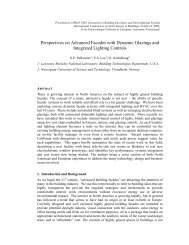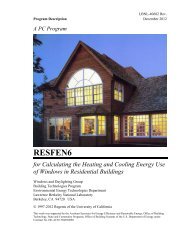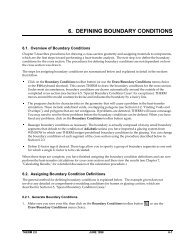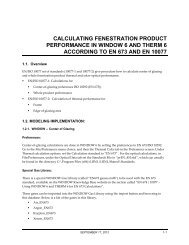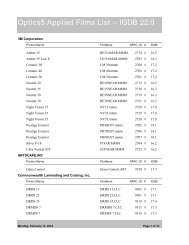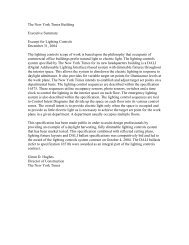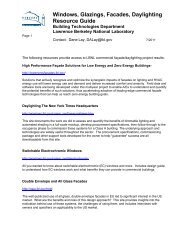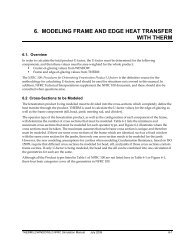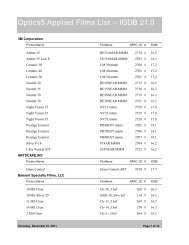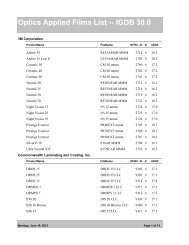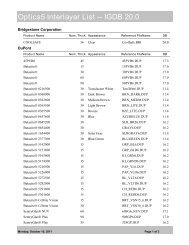Glazings for the 21st Century - Windows and Daylighting Group
Glazings for the 21st Century - Windows and Daylighting Group
Glazings for the 21st Century - Windows and Daylighting Group
You also want an ePaper? Increase the reach of your titles
YUMPU automatically turns print PDFs into web optimized ePapers that Google loves.
8<strong>21st</strong> <strong>Century</strong> <strong>Glazings</strong> ...(continued from page 1)Fenestration Facts“Avariant of <strong>the</strong> liquidcrystal display technologyused in wristwatches is nowserving as a privacy glazing<strong>for</strong> new windows. Averythin layer of liquid crystalsis s<strong>and</strong>wiched between twotransparent electricalconductors on thin plasticfilms <strong>and</strong> <strong>the</strong> entire packageis laminated between twolayers of glass. When <strong>the</strong>power is off, <strong>the</strong> liquidcrystals are in a r<strong>and</strong>om <strong>and</strong>unaligned state. Whenpower is applied, <strong>the</strong> electricfield in <strong>the</strong> devicealigns <strong>the</strong> liquid crystals<strong>and</strong> <strong>the</strong> glazing becomesclear in a fraction of a second,permitting view inboth directions.”F A L LW I N T E R1 9 9 7Residential <strong>Windows</strong>John Carmody et al1996LAWRENCE BERKELEYNATIONALLABORATORYENVIRONMENTALENERGYTECHNOLOGIES DIVISIONBUILDING TECHNOLOGIESPROGRAMWINDOWS & DAYLIGHTINGGROUPtime failure as well as to diagnose<strong>and</strong> correct device problems(see page 5).Thin Film DepositionProcessesProcess modification <strong>for</strong> developmentof improved low-emittance<strong>and</strong> solar control coatingscan be achieved through <strong>the</strong> useof advanced plasma technologydeveloped at LBNL. Anewtype of constricted glow-dischargeplasma source was recentlyselected <strong>for</strong> <strong>the</strong> prestigiousR&D 100 Award. Inventedby LBNL researchers AndreAnders, Mike Rubin, <strong>and</strong> MikeDickenson, <strong>the</strong> source was designedto be compatible with industrialvacuum depositionequipment <strong>and</strong> practice. Constructionis simple, rugged, <strong>and</strong>inexpensive. The source can operateindefinitely over a widerange of chamber pressure withoutany consumable parts suchas filaments or grids. Among <strong>the</strong>uses of <strong>the</strong> source are densificationof coatings <strong>for</strong> greater durability,crystallization at low temperatures<strong>for</strong> increased reflectivityor electrical conductivity, enhancementof reactivity to producean o<strong>the</strong>rwise unstablephase or increase depositionrate, <strong>and</strong> control over composition.Several of <strong>the</strong>se sourceshave been fabricated <strong>for</strong> specificuses by glazing manufacturers.LBNL will assist <strong>the</strong>se manufacturersto optimize <strong>the</strong> sourcecharacteristics <strong>and</strong> to developnew coating types. Recently, alinear configuration was successfullytested. Consisting ofan array of miniaturized versionsof <strong>the</strong> original source, thislinear source is extendible to adeposition system of any width.International Collaborationon Optical MaterialsLBNLstaff continue to participateactively in several international<strong>for</strong>ums under <strong>the</strong> auspicesof <strong>the</strong> International EnergySimulation tools, such as <strong>the</strong>se RADIANCE ray tracing images, comparevisibility of a computer screen with conventional clear glass (lower left),tinted glass (lower right), <strong>and</strong> electrochromic glass (top left), using two differentcontrol strategies.Agency (IEA). LBNL led <strong>the</strong>subtask on Chromogenics underIEATask 18 which concluded inMarch. Switchable glazing technologiessuch as liquid crystals<strong>and</strong> <strong>the</strong>rmochromics, as well aselectrochromics, were investigated<strong>and</strong> compared. Asurveywas made of <strong>the</strong> companies involvedworldwide <strong>and</strong> <strong>the</strong> statusof <strong>the</strong>ir technology. Test methods<strong>and</strong> results were compared<strong>for</strong> a variety of small sampletypes <strong>and</strong> some large electrochromics.Energy per<strong>for</strong>manceof <strong>the</strong>se technologieswas evaluated in ano<strong>the</strong>r subtaskled by Bob Sullivan ofLBNL. Reports were producedon various specific technologies<strong>and</strong> a final report will be availablelater this year. One newstudy used DOE-2 to evaluate<strong>the</strong> per<strong>for</strong>mance of angle-selectiveprototypes developed byProf. Geoff Smith of <strong>the</strong> Universityof Technology at Sydney.(See <strong>the</strong> regular update onIEATask 18 on page 2).Materials CharacterizationStudiesCharacterization of <strong>the</strong>se newglazing materials is an importantpart of our research. Structural<strong>and</strong> compositional analysisis per<strong>for</strong>med using a variety offacilites available at LBNL.These techniques range fromst<strong>and</strong>ard techniques such as x-ray diffraction, or less commontechniques such as Nuclear ReactionAnalysis <strong>for</strong> detection oflithium in electrochromics, toexotic <strong>and</strong> unique applicationsof atomic resolution electronmicroscopy or <strong>the</strong> syncrotron atLBNL's Advanced LightSource. Amore complete listing<strong>and</strong> description of <strong>the</strong>se generalmaterials science capabilitiesmay be found on LBNL's website, http://www.lbl.gov. Optical<strong>and</strong> <strong>the</strong>rmal characterization ofwindows are of particular importanceto our energy efficiencyprogram, so we maintainspecialized facilites in <strong>the</strong>seareas. Thermal facilites werehighlighted in previous issues.The Optical CharacterizationFacility <strong>for</strong> glazing is describedin detail in a separate article onpage 6.ContactMike Rubin(510) 486-7124 Fax (510) 486-6099e-mail: MDRubin@lbl.gov



